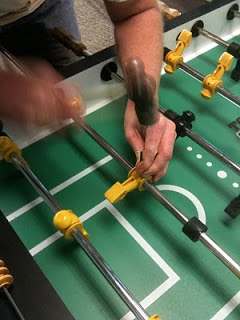Setting up a foosball table can seem tricky at first. But with the right steps, it becomes easy and fun.
Foosball is a popular game enjoyed by many. Whether you’re setting up a new table or reassembling an old one, knowing the right process is crucial. A well-set foosball table ensures smooth gameplay and longer durability. In this guide, we will walk you through each step to set up your foosball table correctly.
This way, you can enjoy countless hours of fun with family and friends. Ready to get started? Let’s dive into the details and have your table ready for action!
Choosing The Right Foosball Table
Setting up a foosball table begins with choosing the right table. The right choice ensures fun and long-lasting play. Let’s explore different table types and their sizes.
Table Types
Foosball tables come in various types. Each serves different needs. The main types are standalone, table-top, and multi-game tables.
Standalone tables are sturdy and offer a professional feel. They are ideal for serious players. Table-top versions are portable and easy to store. They suit casual players or small spaces. Multi-game tables provide several games in one unit. These are great for families and kids.
Size And Dimensions
Consider the size and dimensions before buying a foosball table. Standard tables are about 56 inches long and 30 inches wide. Smaller tables are available for limited spaces.
Ensure you have enough room to play comfortably. Leave space around the table for movement. Measure your area and match it to the table’s dimensions. This prevents any issues later.
Preparing The Assembly Area
Setting up a foosball table can be a fun project. But, it requires proper preparation. Ensuring a well-organized assembly area can make the process smoother. Let’s explore how to prepare your assembly area effectively.
Selecting A Location
Choosing the right location is crucial. The spot should be spacious enough to accommodate the table and allow players to move freely.
- Find a flat and stable surface.
- Avoid placing the table near fragile items.
- Ensure there’s enough room for players on all sides.
A good rule of thumb is to leave at least 3 feet of space around the table. This ensures comfortable gameplay.
Gathering Tools
Having the right tools at hand is essential. This will prevent interruptions during assembly.
| Tool | Purpose |
|---|---|
| Screwdrivers | For tightening screws and bolts. |
| Wrenches | To secure nuts and bolts. |
| Allen Keys | For assembling specific parts. |
| Measuring Tape | To ensure proper alignment. |
Lay out all tools before starting. This helps you stay organized and efficient.
By selecting an appropriate location and gathering all necessary tools, you set the stage for a smooth assembly process. Your foosball table will be ready for action in no time.
Unboxing The Foosball Table
Setting up a foosball table can be an exciting task. The first step is unboxing the table. This step is crucial. It ensures you have all the necessary parts and tools. Let’s go through it step by step.
Checking Contents
Begin by opening the box carefully. Take care not to damage anything inside. Use a box cutter or scissors. Cut along the tape. Once the box is open, check the contents against the instruction manual.
Here is a simple checklist for you:
- Tabletop
- Legs
- Rods
- Players
- Balls
- Screws and bolts
- Instruction manual
Verify that all parts are present. If something is missing, contact the manufacturer immediately.
Organizing Parts
After checking the contents, organize the parts. This makes the assembly process smoother. Lay out each component in an open space. Group similar items together.
For instance:
- Place all screws and bolts in a small container.
- Line up the rods and players in order.
Refer to the instruction manual. Ensure you understand each step before proceeding. This preparation helps avoid mistakes during assembly.
Use the following table to organize your screws and bolts:
| Type | Quantity |
|---|---|
| Long screws | 8 |
| Short screws | 16 |
| Bolts | 4 |
Having a clear setup area will save you time. It also makes the process more enjoyable. Happy assembling!

Credit: www.youtube.com
Assembling The Table Base
Setting up a foosball table can be a fun experience. The first step is assembling the table base. This ensures a solid foundation for your game. Let’s look at how to attach the legs and secure the frame.
Attaching Legs
Start by placing the table base upside down. This makes it easier to attach the legs. Each leg will have pre-drilled holes that align with the table base. Use the screws provided in the kit. Insert the screws through the holes and tighten them with a screwdriver.
Make sure all screws are tight. This prevents wobbling during the game. Check each leg to ensure they are secure. Repeat this process for all four legs. Properly attached legs provide stability for your foosball table.
Securing The Frame
Once the legs are attached, it’s time to secure the frame. Align the frame pieces as shown in the instruction manual. Connect the pieces using the provided bolts and nuts. Hand-tighten the bolts first to ensure proper alignment.
After aligning, use a wrench to fully tighten the bolts. This creates a sturdy frame for your table. Double-check all connections to ensure they are secure. A well-secured frame will provide a solid playing surface.
With the legs attached and the frame secured, your foosball table base is ready. These steps are crucial for a stable and enjoyable game. Now you can move on to the next steps in setting up your foosball table.
Installing The Playing Field
Setting up the playing field is crucial for a smooth foosball game. This step ensures that the ball rolls evenly and the players move correctly. Follow these steps to install the playing field properly.
Aligning The Field
First, position the playing field inside the table. Make sure it sits flat and doesn’t wobble. Check if the field is centered. Both sides should have equal space. This alignment ensures fair play for both teams.
Use a level tool to check the flatness. Place the level in different spots. Adjust the field if necessary. A level playing field is vital for a fair game.
Tightening Screws
Once the field is aligned, secure it with screws. Use a screwdriver to tighten each screw. Ensure all screws are tight. Loose screws can cause the field to shift during play.
Check the screws regularly. Over time, they may loosen. Tight screws ensure the field stays in place. This stability is key for a consistent game.
Here’s a quick table to summarize the steps:
| Step | Description |
|---|---|
| 1. Position the Field | Place the field inside the table, ensuring it sits flat. |
| 2. Check Alignment | Ensure the field is centered and level. |
| 3. Secure with Screws | Tighten all screws to keep the field in place. |
| 4. Regular Check | Inspect screws regularly to ensure they stay tight. |

Credit: www.youtube.com
Mounting The Rods And Players
Mounting the rods and players on a foosball table is crucial. It ensures smooth gameplay and long-lasting enjoyment. Properly mounted rods and players contribute to the balance and precision of the game. Follow these steps to set up your foosball table like a pro.
Inserting Rods
Begin by identifying the rods. Each rod has a specific position on the table. Insert one rod at a time through the holes on the side panels. Make sure the rods slide smoothly. If they stick, check for debris or misalignment.
Alternate the rods for each side. This means if you insert a rod from the left side for one player, insert the next rod from the right side. This maintains balance. Ensure the handles are on the correct side for each rod.
Attaching Players
Once the rods are in place, attach the players. Align the players with the rod holes. Slide the players onto the rods. Secure them with the provided screws or pins. Ensure they face the correct direction. Their feet should point towards the opponent’s goal.
Check the spacing between players. They should be evenly spaced for fair play. Tighten each player securely. Loose players can affect gameplay. After attaching all players, give each rod a quick spin. They should move smoothly without wobbling.
By following these steps, your foosball table will be ready for action. Enjoy your game with friends and family!
Finalizing The Assembly
You’ve come a long way in setting up your foosball table. Now, it’s time to finalize the assembly. This step ensures your table is ready for action. Pay attention to detail here. The final touches make a big difference.
Adding Accessories
Start by adding the accessories. These include balls, score markers, and handles. Place the balls in the ball return areas. Attach the score markers on each end of the table. Ensure they move smoothly. Next, secure the handles onto the rods. Check that they are tight. Loose handles affect gameplay.
Ensuring Stability
Now, ensure the table’s stability. This step is crucial for a fair game. First, check the table’s legs. Make sure they are even. Use a level tool if needed. Adjust the leg levelers until the table is stable. Don’t forget to tighten all screws and bolts. Loose parts can cause wobbling. Finally, test the table by gently rocking it. It should not move. A stable table makes for a better game.

Credit: www.instructables.com
Tips For First-time Players
Setting up a foosball table is just the beginning. Understanding the basics can make the game more enjoyable. Let’s explore some useful tips for first-time players. These tips will help you get started and improve quickly.
Basic Rules
Knowing the rules is crucial. Each team has 11 players on the rods. The goal is to score by getting the ball into the opponent’s goal. Players can’t spin the rods. Spinning is when a rod turns more than 360 degrees.
Each game starts with a coin toss. The winner of the toss serves the ball. The game ends when one team reaches the set number of goals. Usually, it’s five or ten.
Essential Techniques
Mastering techniques can improve your skills. Focus on grip first. Hold the rods with a relaxed grip. This allows better control and precision.
Practice ball control. Keep the ball close to your players. Move it smoothly between rods. This helps set up for a shot or pass.
Learn to pass effectively. Use short, quick passes between your players. This confuses your opponent and creates scoring chances.
Shooting is key. Practice different shots like the push shot and pull shot. Experiment with angles and power. Find what works best for you.
Defense is important too. Block your opponent’s shots. Keep your players in the right positions. This makes it harder for them to score.
Frequently Asked Questions
What Tools Do I Need To Set Up A Foosball Table?
You need a screwdriver, wrench, and Allen key. These tools help assemble the table parts securely and correctly.
How Long Does It Take To Set Up?
Setting up a foosball table takes about 1-2 hours. This time frame includes unpacking, assembling, and final adjustments.
Can One Person Assemble A Foosball Table Alone?
Yes, one person can assemble it alone. However, having an extra pair of hands makes the process easier and quicker.
Are There Any Safety Tips For Assembly?
Yes, read the manual carefully. Use tools properly and avoid over-tightening screws to prevent damage and ensure safety.
Conclusion
Setting up a foosball table is simpler than you think. Follow the steps above carefully. Ensure every part is secure and aligned. Double-check the rods and players. Test the table before starting a game. Invite friends over for a fun match.
Practice often to get better. Enjoy countless hours of entertainment. Happy playing!


